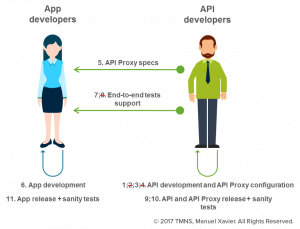A team of experts exclusively dedicated to API Management asset configuration increases project complexity
Have you read part 1?
This is part 2 in a series on Self-service API Management. To fully understand this matter we advise you to read part 1 of this series first.
Part 2 starts here!
Taking away the responsibility of asset configuration from API and App developers, and centralizing it in a third team dedicated exclusively to API Management Platform configuration, will increase the complexity of the delivery process.
A dedicated team will have to interface with both API and App developers creating new interdependencies impairing the Agile delivery process that organizations are actually trying to promote.
The following diagram depicts a pragmatic view of the API delivery process supported by three teams:
The creation of an extra hop between API providers and API consumers eliminates their direct communication, creates a barrier between both roles, and leads to redundant work around the documentation of API specifications and the testing of delivered assets.
Removing the explicit role of API Management Configuration Expert and enabling Self-service will simplify the whole process, lessening the excessive chaining of dependent tasks:
Extra benefits of a streamlined process include the functional knowledge API developers can provide to App developers, and the increased automation of the DevOps processes (i.e. Continuous Integration and Continuous Delivery).
Would you like to know more about API Management?
We can assist your organization with workshops on the topics. Our consultants have led API Management platform rollout processes in multiple domains and will guide you in the creation of an API center of excellence delivering consumer grade APIs.
More about API Management at Devoteam?
- Offer: EAI and API Management
- Offer: API Management
- Case Study: API Management at Liberty Global Inc.
- Blog series: Self-service API Management
- Blog series: Axway API Management
- Blog: Best breed of API Management Platforms
Read part 3


